Alexander Keynote Address
You have probably already seen the news articles on the morning keynote address by General B. Keith Alexander, Commanders, U.S. Cyber Command and Director, National Security Agency, Agency/Chief, Central Security Service, here is my take on the address. The major theme was “The Balance between Security and Privacy”. Gen. Alexander started by saying he wanted to share the facts and spoke about why we sometimes do not get all the facts because classification of some material. He also wanted to support the NSA employees saying – “they are noble folks doing great work but now have a tarnished reputation”. Over 20 NSA employees were killed while forward deployed to Irag and Afghanistan and he wanted to highlight that at times the NSA does have lives on the line.
He gave a historical perspective of the Intelligence time line starting from 1993 forward and how it had evolved. The he went in to describe U.S. Patriot Act Section 215 and the implication for business records. This was followed by an overview of U.S. Patriot Act Section 702 and an overview of FISA. He emphasized that under Section 702 the NSA only targets terrorists and is prohibited by several checks and balances from targeting others (to me it sounded a lot like self-regulation). He then reviewed samples of the records they capture which are limited to to/from phone numbers, the carrier and source (e.g., FISA-B). It seems that if a number is identified as potentially involving terrorists the calls to and from the number after some internal review are turned over to the FBI who then in turn use probable cause to get warrants in order to identify who owns the numbers and make the tie to people. Only 22 people in NSA can approve a number that can be queried in the Meta Data database, 35 people are allowed to run the queries. All of this he says is 100% auditable using records and oversight by multiple governmental agencies including judicial and administrative branches.
At different point in the General’s address there were a few catcalls from the audience about Liberty and freedom, and “I do not trust you, you lied to congress”. The General handled these with patience and some cases responded to person with an actual answer. He did review actual cases where the programs had worked like the case for Najibullah Zazi and Adis Medunjanin and the New York City subway bombing plan, which was averted due to NSA data. He gave statistics saying that the NSA so far had helped disrupt 54 terrorist related activities: 13 in the U.S., 5 in Africa, 25 in the E.U and 11 in Asia.
He most resounding response to the cat calls was when he said – “ I am here with greatest talent pool of technical talent and I want your help. If you do not like what we are doing help us to make it better”.
Muirhead Keynote Address (Take Risk But Don’t Fail)
Brian Muirhead, Chief Engineer and the NASA Jet Propulsion Laboratory(JPL) had what I consider to be a very relevant and motivating keynote message. He gave an overview of the many JPL projecst he has been involved with over the years from the Gallileo Mission to Jupiter, to Mar Pathfinder, Constellation Mission and more recent Curiosity Missions. My mind was taken back to my youth and the huge interest I had in the Space Program and what were doing in space exploration from the age of the Mercury Mission through the Space Shuttle and Space Station missions. He said “visionaries see solutions and entrepreneurs create solutions”. He feels that constraints can drive innovation.
He described for the audience the challenges faced and the solutions formulated in various space efforts. Most interesting was the story behind the sky crane used to deploy the Curiosity rover on Mars. This was a fascinating insight in to how JPL teams address unknown unknowns and mitigate risks for them. The story involved what called the “7 Minutes of Terror”. This the story of the 7 minutes during which Curiosity had to go from 13,000 miles per hour to zero by landing on Mars. For more details on this great story see ‘Huge Mars Rover’s Landing Will Be ‘7 Minutes of Terror’.
It was sad to realize that some recent big budget movies have budgets bigger than some of our more significant space exploration missions. Maybe we should make more movies about our real space initiatives to help fund the exploration. The technologies, innovation and engineering involved in these space missions is amazing. The quote for this talk came from a real quote given to Brian as he was starting his involvement with the space program and is very applicable “Take Risk, But Don’t Fail”. It relates to techniques JPL uses to formulate cohesive teams where members support one another’s efforts and focus completely on the overall success of the mission. This is the key to JPL’s success with these missions. Brian emphasizes that it manager also help provide the “glue and the grease” for these teams. This was a very motivating and inspiring presentation!
